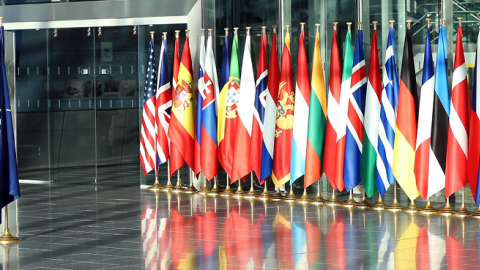The Trump administration has been vocal in its criticism of NATO allies for their failure to make good on commitments to devote 2 percent of GDP to defense. And in many cases, allied defense budgets are going up, however reluctantly.
The rancor over budgets, however, has overshadowed a more fundamental problem: Military power has shifted from weapons platforms to data. Fortunately, advances in technology now offer a way out of the curiously outdated debate over burden-sharing. Cloud services are the best path forward for NATO’s members to both modernize their military collaboration and patch up their differences.
Even if it came to pass, a decade of NATO members investing 2 percent of GDP in equipment and concepts of operation appropriate to the wars of the late 20th century would leave NATO weaker, not stronger. Military power in the 21st century resides in information and networks, not in individual aircraft, ships, or armored vehicles.
Collaboration within the alliance has historically been constrained by difficulties in sharing information. Technical and administrative inefficiencies have often condemned NATO partners to cooperate by leadership coordination rather than true integration and interoperability of force structures. In recent years, this issue has become particularly stark. Today, the evolution of military operations is increasingly driven by the vast influx of data from equipment and sensors that enable armed forces to assess their environment as rapidly and comprehensively as possible.
The ability to exploit this information – to gain usable insight from reams of computer code – builds on advances in data sciences, computation, and communication. And its transformational effect has been proved repeatedly during campaigns against terrorism in the Middle East and around the world. Yet the United States has developed these capabilities largely acting on its own, meaning that NATO has one member that is “information-abundant” while the others are “information-impoverished.”
However, there is good news. Because the underlying technology is already widely understood and used in commercial and government applications, cloud can offer NATO a key advantage. By centralizing the flows of military data it provides a way to integrate information across continents and different nations’ armed forces.
An additional benefit is that cloud services can adapt to different needs and scenarios. Typical large-scale commercial users benefit from multiple cloud service providers, each offering specialized capabilities and features. The military will likely adopt an approach that parallels this commercial practice, operating across a number of “fit for purpose” clouds in a hybrid cloud infrastructure.
The Pentagon is taking steps to ensure that America leads in the application of cloud services to military operations. Today, the Department of Defense (DoD) is working to integrate its more than 500 cloud-based IT systems into a broader “enterprise cloud” known as the Joint Enterprise Defense Infrastructure (JEDI), which will bring together all of the DoD’s digital information for data storage, processing, and dissemination.
In essence, cloud offers an opportunity to bring NATO’s military operations into the 21st century. At a security conference in Munich this year, I noted the presence of a German Army officer who was wearing a coveted U.S. military award – the Army’s Combat Infantry Badge. In our conversation, I learned that the soldier earned it in combined operations with U.S. Army Special Forces soldiers in the early stages of the campaign against Al-Qaeda in Afghanistan.
This soldier is testament to the underlying strength of the transatlantic alliance, a strength that transcends the day-to-day and year-to-year difficulties in managing a partnership of 27 nations.
Information-sharing is the best path to reinvigorating the camaraderie of the NATO allies – and cloud is the tool to get it done.

















